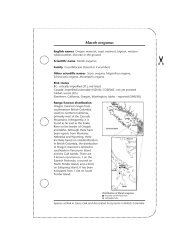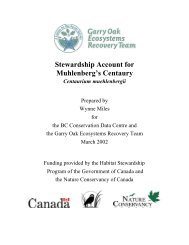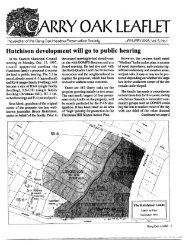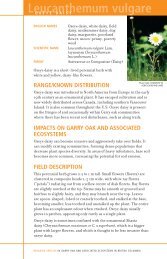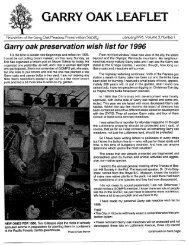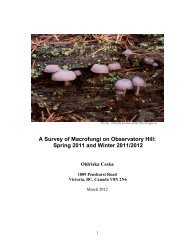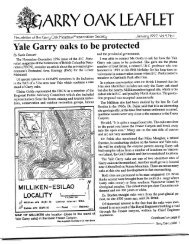PDF 320KB - Garry Oak Ecosystems Recovery Team
PDF 320KB - Garry Oak Ecosystems Recovery Team
PDF 320KB - Garry Oak Ecosystems Recovery Team
Create successful ePaper yourself
Turn your PDF publications into a flip-book with our unique Google optimized e-Paper software.
RARE SPECIES BIOLOGY<br />
A COMPARATIVE ANALYSIS OF THE EPIPHYTE<br />
COMMUNITIES FOUND ON GARRY OAK BARK AT<br />
THE COWICHAN GARRY OAK PRESERVE AND<br />
THE LANSDOWNE CAMPUS OF CAMOSUN<br />
COLLEGE<br />
Anne Anderson and Angela Lougheed<br />
Royal Roads University<br />
Very little is known about epiphytic populations on <strong>Garry</strong> oak.<br />
Therefore, the purpose of this study is to broaden the scientific<br />
community’s knowledge regarding epiphytic populations found on<br />
the trunks of <strong>Garry</strong> oak trees. The report details the study of epiphyte<br />
population distributions on <strong>Garry</strong> oak trunks at the two sites. The<br />
report includes multivariate analysis using PCORD and Minitab<br />
statistical software to compare the abundance and diversity of<br />
epiphytes on <strong>Garry</strong> oak bark on three different levels:<br />
1. Between the two sites<br />
2. Between the cardinal directions of the trees<br />
3. Between the tree’s size classes within each site<br />
Methodology for the experiment involved a sample design of eight<br />
trees with two size classes at each site. The “small” size class included<br />
trees with circumferences between 1.0 m and 1.5 m; trees with<br />
circumferences greater than 1.5 m were in the “large” size class.<br />
Trunks were sampled at a height of 1.3 m using 10 cm x 10 cm square<br />
mesh grids; each grid was one cm 2 . Three grids were placed per<br />
cardinal direction of the tree (sample unit). A sequential sampling<br />
design (i.e., alternating intersections) of 50 intersections per grid was<br />
chosen. A sewing needle was inserted at the upper right corner of the<br />
marked intersection on the grid, and the epiphyte touched by the pin<br />
was recorded. The data collected were analyzed using various<br />
statistical tests.<br />
<strong>Garry</strong> <strong>Oak</strong> <strong>Ecosystems</strong> <strong>Recovery</strong> <strong>Team</strong> – Research Colloquium 2010 Page 6




